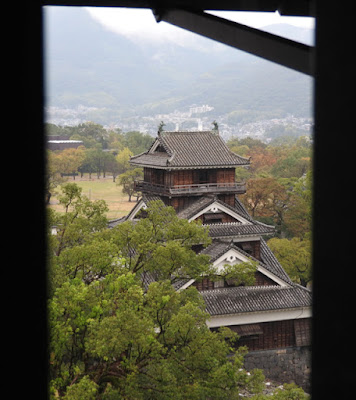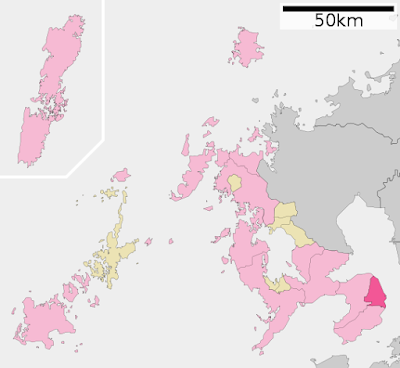1) 天守閣 / Castle Towers
2) 本丸御殿 / Hon-maru Goten
1) 天守閣 / Castle Towers
2) 本丸御殿 / Hon-maru Goten
加藤清正 (1562 -1611)が行政と生活の場所として、本丸御殿 (ホンマルゴテン)を建造しました 。
本丸御殿は、畳数1570畳、部屋数53もある建物群でした。
が、それは西南戦争(1877)のときに焼失しました。
2003年から大広間(対面所)、数寄屋(茶室)、大台所等、復元工事がされ2008年に完成しました。
公式サイト : ★
Hon-maru Goten
Hon-maru Goten : Main Palace buildings were built for administration and residence by Katō Kiyomasa (1562 -1611) , however, they were burnt during the Satsuma Rebellion in 1877.
The Goten : Palace was a building cluster which had 1,570 tatami mats in 53 rooms.
The restoration started in 2003 and completed in 2008.
Official Website : ★
1) 天守閣 / Castle Towers
 |
案内板
熊本城の規模の大きさがわかります。
熊本城は国宝です。
Guide Map I can see scale of the Kumamoto Castle Area.
The
Castle is a National
Treasure.
|
 |
| パンフレット : 上 : 日本語 / 下: 英語 Pamphlets : top : Japanese / bottom : English |
 |
熊本城
熊本城に行きました。
ここも、雨、雨、雨....屋内見学がメインなのが救われました。
大小二つの天守閣があるのですね〜。
もとは千葉城
(チバジョウ/
1469 -1767) というお城があったのが始まりです。
公式サイト
: ★
Kumamoto Castle We went to the Kumamoto Castle. Here, rain, rain and rain, too. It was good main sightseeing places were inside. The castle has two castle towers : big one and small one, hasn't it? Originally Chiba Castle built nearby ; 1469~1767. The Kumamoto Castle is also called 'Ginnan Castle' : 'Ginko Castle'. Official Website : ★ 
小さい天守閣からの景色,
大銀杏
熊本城となったのは、加藤清正 (1562
-1611) が、
1607年に築いたお城からです。 そのときに加藤清正が銀杏を植えました。 加藤清正が、亡くなるときに、 「この銀杏の木が天守閣と同じ高さとなったときに、何か異変が起こるであろう」 と予言し、1877年の西南戦争のときであったとも言われています。 こうい逸話があり、'銀杏城' と呼ばれます。 現在の銀杏は西南戦争で燃えたあとに、芽吹いた脇芽が成長したものです。
銀杏だけでなく、西南戦争のときに熊本城は炎上しています。
お城は燃えてしまったものの、籠城は成功し、
'不落の名城'と言われるようになります(★)。
View from Small Castle Tower, Great Ginko Tree Katō Kiyomasa (1562 -1611) had built the castle which
became
the Kumamoto
Castle in 1607.
At
that time, he planted a Ginko.
They say that just before he died he foretold 'When the tree's height will be the same as the Castle Tower, something will happen.' and when the tree reached as high as the tower,
there
was the Satsuma
Rebellion in 1877.
The current tree is from the side bud of the original which
was
burnt in the Satsuma
Rebellion.
They
have the stories so it is known as 'Ginnan Castle' : Ginko
Castle.
In
the Rebellion not only the tree was burnt, but also the Kumamoto
Castle.
However,
the castle resisted the siege successfully and after then it
became called
'the
Fine Impregnable Castle'. |
 |
| パンフレットの地図の一部分 / A part of Map in Pamphlet in Japanese |
 |
戌亥櫓 (イヌイヤグラ)、2003年復元
これだけ見せられて、お城ですと言われたら信じてしまいます。
Inui Yagura : Inui Turret, Restored in 2003
If somebody only showed me this and said this is a castle,
I could believe it.
天守閣の窓から / From Castle Tower Window
|
 |
| 英語版パンフレットの地図の一部分/ A Part of Map in Pamphlet |
 |
| 天守閣の西側から 1600年に天守完成 / 1960年復元完成 From the West to Castle Towers Tenshu : Keep Completion in 1600 / Restoration Completed in 1960 
武者返し
熊本城の特徴のひとつは、石垣です。 優美にして堅牢な石垣は「清正流」と江戸時代(1603 -1868) から言われています。 またの名を'武者返し'、最初は穏やかですが、上に行くほど角度が 急になっています。 西南戦争のときに武者返しが大変役に立ち、 西郷軍は誰一人として入城できなかったそうです。 Stone Walls The Stone Walls are a special feature of Kumamoto Castle. They are beautiful and strong, it has been called 'Kiyomasa Style' since the Edo Period (1603 -1868) . The curve is moderate close to the ground and increases rapidly and progressively, it is called 'Musha Gaeshi' ; 'Fall Back Samurai'. During the Satsuma Rebellion, nobody of the Saigo Army could get into the castle. 画像は下記より / Thsi from below ★ |
大天守から小天守を見る
From Big Tower to Small Tower
 |
| この写真を気に入っています。 / I like this photograph. |
 |
| 江戸時代 (1603 -1868) の模型 模型は天守閣の中に展示されています。 Diorama of Edo Period (1603 -1868) This is displayed in the Main Tower  |
加藤清正 (1562 -1611)が行政と生活の場所として、本丸御殿 (ホンマルゴテン)を建造しました 。
本丸御殿は、畳数1570畳、部屋数53もある建物群でした。
が、それは西南戦争(1877)のときに焼失しました。
2003年から大広間(対面所)、数寄屋(茶室)、大台所等、復元工事がされ2008年に完成しました。
公式サイト : ★
Hon-maru Goten
Hon-maru Goten : Main Palace buildings were built for administration and residence by Katō Kiyomasa (1562 -1611) , however, they were burnt during the Satsuma Rebellion in 1877.
The Goten : Palace was a building cluster which had 1,570 tatami mats in 53 rooms.
The restoration started in 2003 and completed in 2008.
Official Website : ★
 |
昭君之間
(ショクンノマ)
/ Shokun-no-ma Room
一番格式の高い部屋
下記公式サイト
: ★から
"この部屋には、中国の漢の時代のお話で、胡の国に送られた絶世の美女、
王昭君の物語が描かれていました。
「昭君の間」は実は「将軍の間」の隠語であるという説もあります。
熊本城を造った加藤清正は豊臣秀吉子飼いの武将。
その遺児である秀頼に万が一のときは、清正にはこの熊本城に秀頼を迎え入れ、
西国武将を率いて徳川に背く覚悟があり、そのための部屋が
「昭君の間」というのです。
また、昭君の間には抜け穴伝説もあります。
熊本城築城に携わった大工の棟梁善蔵(ぜんぞう)が語った
「大工善蔵より聞覚控」という古文書が残されています。
〜
〜 〜
「昭君の間の後ろの壁が回り、床下の通路にはしごと縄で下りれば、
そのまま門をくぐって城外へ出れるようになっていた。」そうです。"
昭君之間
(ショクンノマ)
/ Shokun-no-ma Room
According
to Official Website about this room : ★
"In
O-Hiroma Main Hall of Honmaru Goten Palace,
the
most prestigious room is said to be Shokun Hall.
The
Chinese legendary Lady Shokun is drawn on the walls and sliding
doors.
Actually,
it is said that this room was to welcome Hideyori,
the
orphan of Hideyoshi Toyotomi, to Kumamoto Castle.
There
is a theory that the name Shokun Hall is slang for Shogun Hall." |
 |
| 影が美しかったのですが、残念ながら、 私の写真ではそれをキャッチできていません。 The shadows were beautiful, unfortunately my photograph cannot catch the beauty. |
 |
| お堀 どうしてかは自分でもわからないのですが、 日本でも英国でも、どこでも、お堀を、水があろうとなかろうと いつも撮影します。 Moat I do not know why I always photograph moats in Japan, Britain and anywhere, it doesn't matter whether there is water or not. |
 |
パンフレット / Pamphlets 
パンフレットは雨に濡れてしわしわです。
Our pamphlet got wet with rain and now it is wrinkled. |































